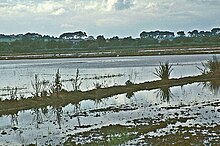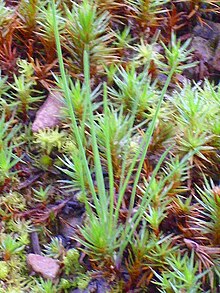Roque-Haute nature reserve
The Roque-Haute nature reserve is located in the Occitania region of southern France . It was set up in 1975 on the site of an extinct volcano . Over 200 small lakes are under protection on 154.64 hectares that were created after the basalt quarry was closed.
location
The national nature reserve Roque-Haute, French Réserve naturelle nationale de Roque-Haute , bears the identification number RNN25 among the French nature reserves (French Réserves naturelles nationales ) and is thus the 25th nature reserve in France. It is located 13 kilometers east-southeast of Béziers in the Hérault department, just 3 kilometers north of the Golfe du Lion and belongs to the territory of the municipalities of Portiragnes and Vias . Roque-Haute is a small basalt plateau, which is dominated by an ash cone of a former volcano that culminates at 41 meters .
The nature reserve should not be confused with Roques Hautes , a fossil site of dinosaur eggs in the Bouches-du-Rhône department .
history
The idea of a nature reserve on the Roque-Haute arose in the 1960s as a response to progressive urbanization and the construction of leisure centers. Scientists who had visited the site since 1876 exerted pressure on the public, so that on March 24, 1964, the Roque-Haute volcano was finally declared a biological protection zone (French: Zone Biologique Protégée ). The official status of a nature reserve (French: Réserve naturelle ) was established by a decree of December 9, 1975 , which was extended by a further decree of July 23, 1998.
Access to the nature reserve is regulated and denied to the public.
geology
The Roque-Haute volcano, located in the municipality of Portiragnes and Vias, is one of the southernmost occurrences within the north-south arrangement of the emission centers from Millau to Cap d'Agde (and several tens of kilometers into the Mediterranean Sea). The age of the volcanoes generally decreases towards the south. The strombolian and therefore explosive volcano of Roque-Haute is the youngest volcano in Languedoc with an age of 640,000 and 560,000 years respectively. Its low height indicates only a short production activity or a low magma capacity. It is still controversial whether it is an extension of the active mantle diapir (hot spot) located under the Massif Central or whether it was created passively by crustal expansion in connection with the Western European rift system in Bas-Languedoc.
ecology
The basalt plateau is covered by 215 non-Perennian ponds , which have a remarkable vegetation . The origins of the ponds and ponds - basalt mining for building purposes and for tool production - go back to prehistory and the Middle Ages. Their size is very variable and can vary between 1 and 2500 square meters. In summer they usually fall dry.
In addition to the damp locations, Mediterranean maquis has also established itself.
flora
A total of almost 600 plant species are registered (including 103 deciduous moss species alone ), 8% of which are protected at national or European level. Unique among the threatened and protected species in France are the rare clover Marsilea strigosa and the bream Isoetes setaceea - both members of the ephemeral lakes ecotope. Also worth mentioning are the bream Isoetes boryana , the adder's tongue Ophioglossum azoricum and the pill fern Pilularia minuta . Further examples of wet areas are the deer-mint Mentha cervina , the purple loosestrife tribracteatum Lythrum and Buttercup Ranunculus ophioglossifolius . The pipe flower Aristolochia clusii , the dummy crocus Romulea ramiflora and the summer root Orobanche arenaria prefer drier locations .
fauna

The fauna found largely depends on these humid locations. The reserve includes around 60 species of vertebrates (amphibians, reptiles, birds, and mammals) and more than 300 species of aquatic invertebrates . Unfortunately, only a few of the invertebrates are protected species. Noteworthy among the invertebrates is the living fossil Triops cancriformis . The amphibians are to lead, among many others of the blade foot Pelobates cultripes , the Western parsley frog Pelodytes punctatus , the marbled newt Triturus marmoratus and the natterjack toad Epidalea calamita . In the reptiles , the find Ocellated Timon lepidus , the Viper snake Natrix maura , the European Malpolon Malpoleon monspessulanus and the Spanish wall lizard Podarcis hispanica . Among the birds appear the European roller Coracias garrulus , the bee-eater Merops apiaster and the hoopoe Upupa epops . When mammals are among others to mention the shrew Crocidura russula , the Etruscan shrew Suncus etruscus and genet ( Genetta ).
Archaeological finds
The finds of a 650,000 year old chopper and a 400,000 year old chopping tool from the Paleolithic underline the importance of Roque-Haute as a very ancient human settlement. In addition to scratches and scrapers , arrowheads , blowstones and ceramic shards also date from the time of the Cro-Magnon man 35,000 years ago . People sedentarisierten on the basalt plateau to 8000 years before present , probably because of the rich volcanic soil but also for its strategic location. At Mourgettes there are building remains from this period with stone fences for sheep breeding. Found grinding stones from basalt, polished stone axes made of basalt and ceramic of Véraza culture . Around 750 BC Ceramic remains of the Iron Age urn field culture appear, which burned their dead and buried them in urns. To the time around 600 BC A ceramic find goes back to the 4th century BC that shows Greek influence . Whether these are barter goods or whether there actually was a Greek settlement in Roque-Haute cannot yet be decided. Against 121 BC Chr. Appear Roman pottery and the remains of a villa on the basalt plateau. At this time the Romans had subjugated southern Gaul and established the province of Gallia Narbonensis . Everywhere along the coast road ( Via Domitia ), bridges ( Roman bridge at Saint-Thibéry ) and building remains bear witness to their presence.
Individual evidence
- ↑ Frechen, J. von and Lippolt, HJ: Potassium-argon data on the age of Laacher volcanism, the Rhine terraces and the ice ages . In: Ice Age and the Present . tape 16 , 1965, pp. 5-30 .
Coordinates: 43 ° 18 ′ 16 ″ N , 3 ° 22 ′ 5 ″ E




